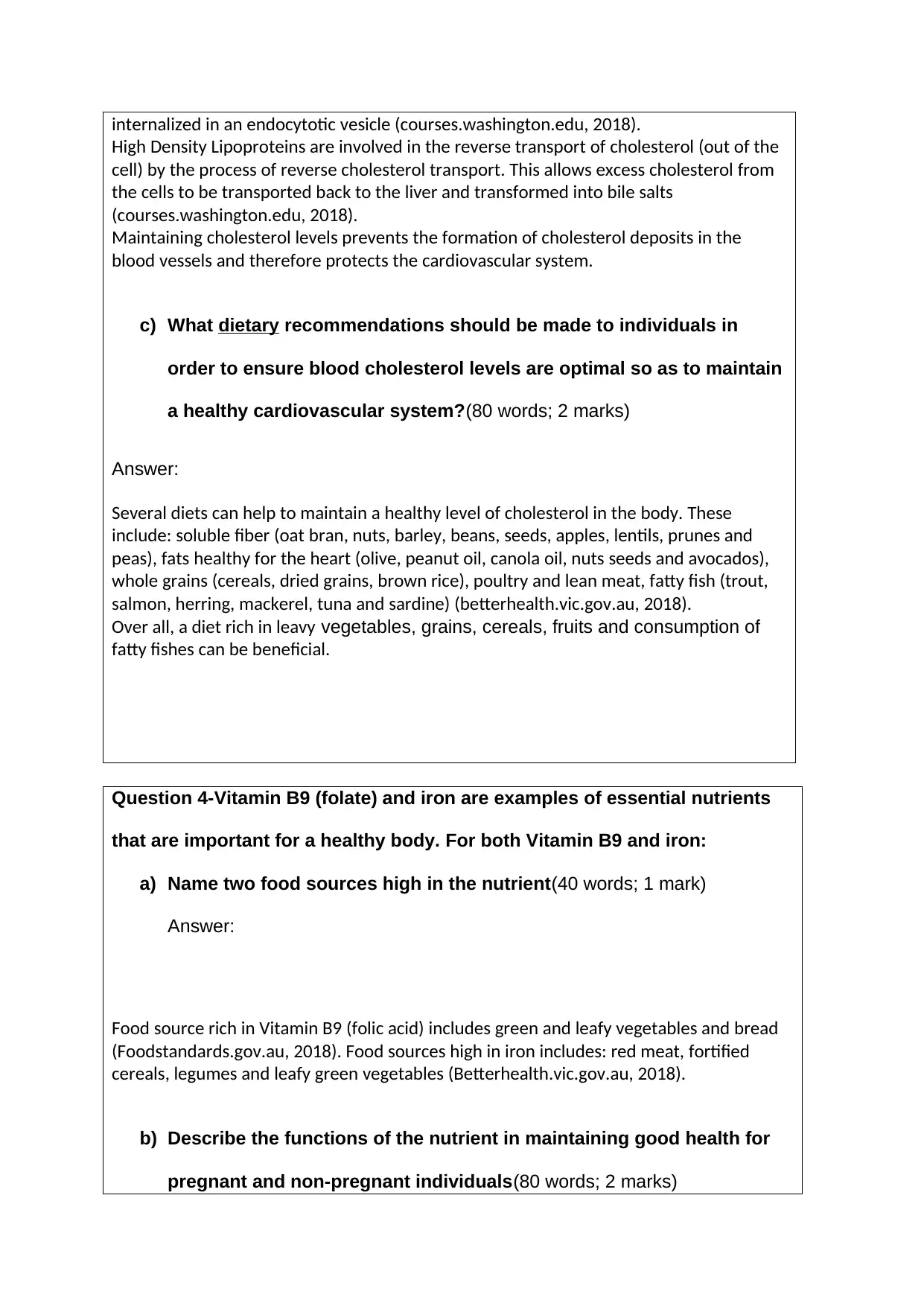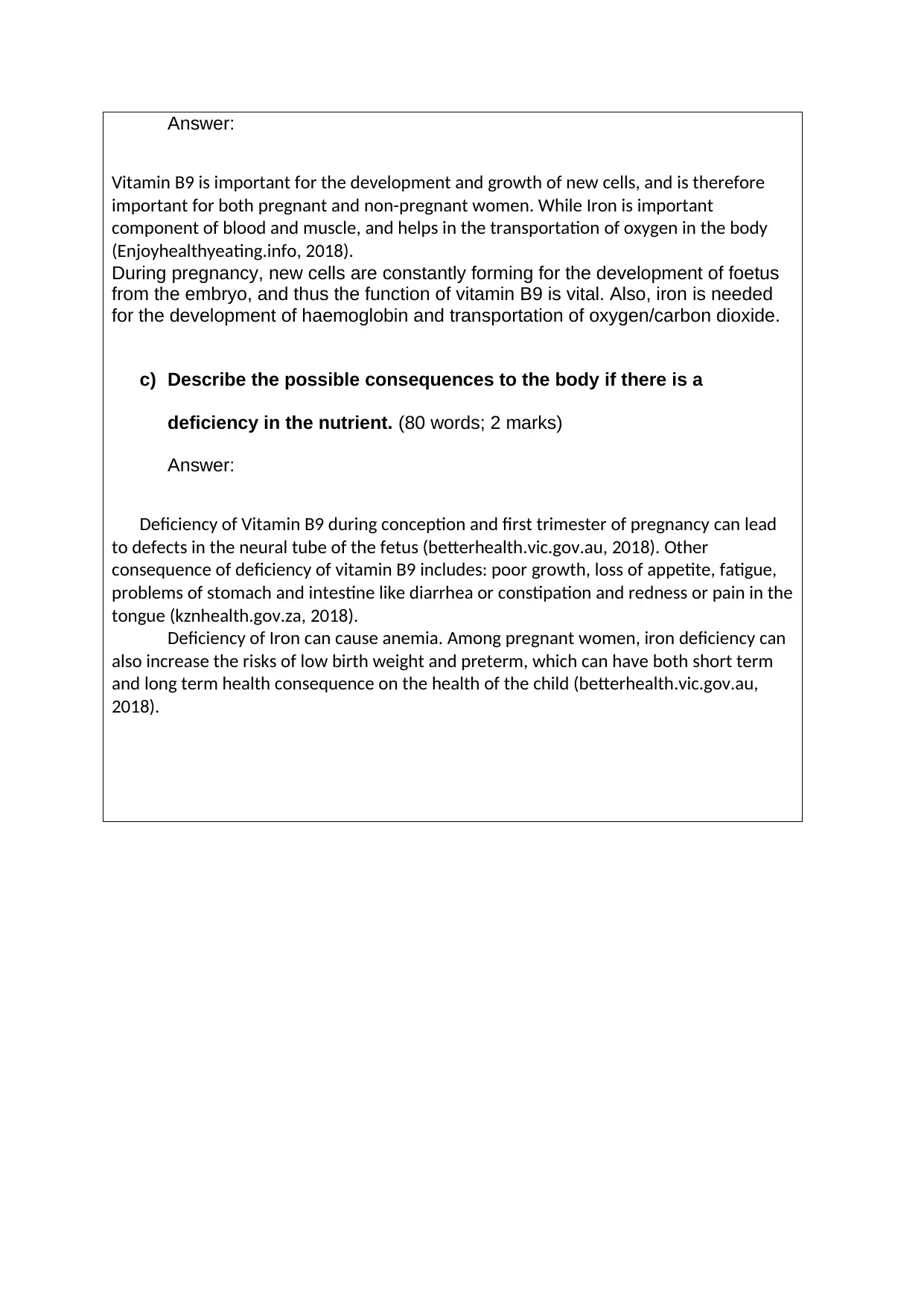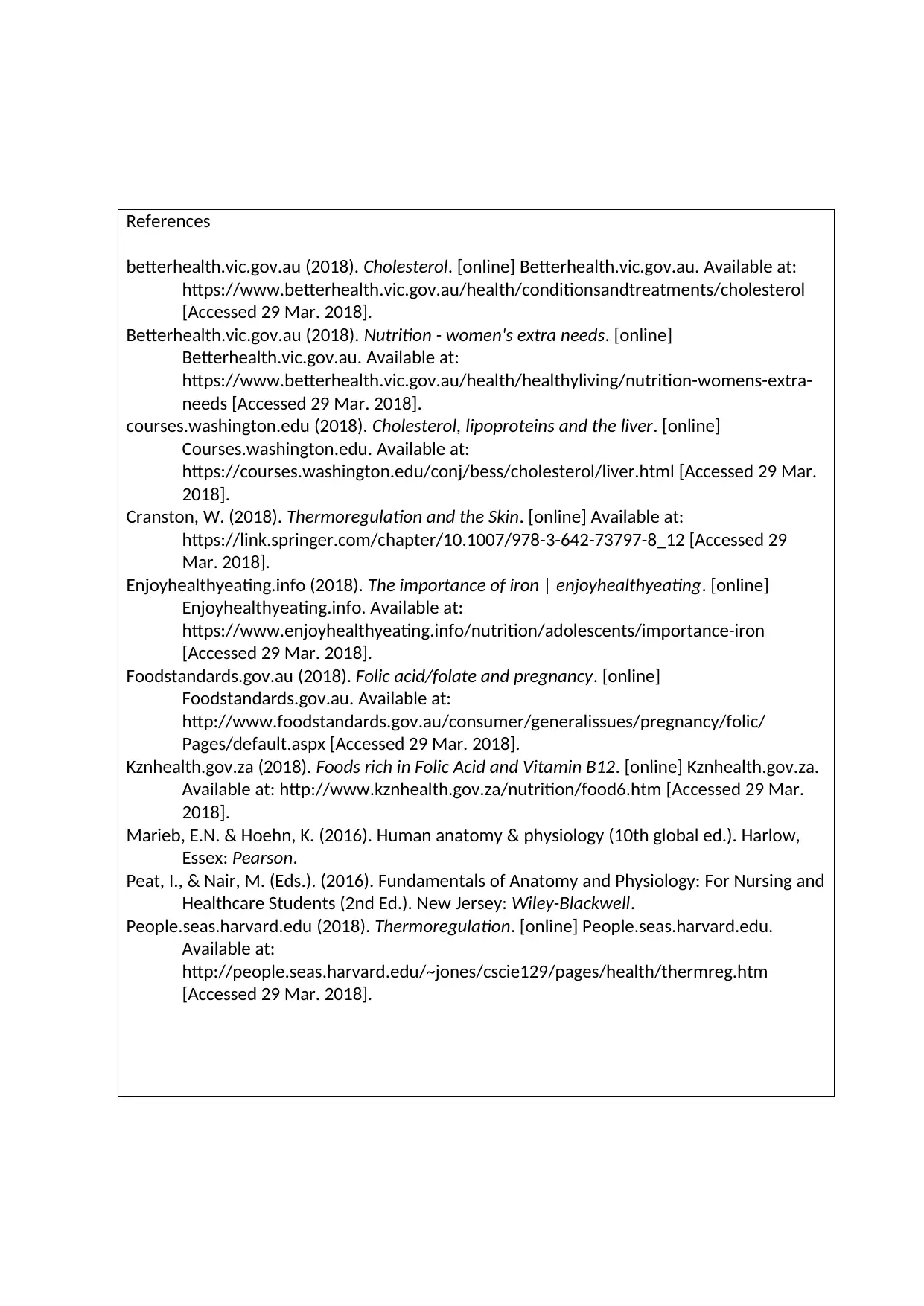Health and Lifestyle Practices Assessment - Module 2, Part B
VerifiedAdded on 2021/04/21
|6
|1682
|133
Homework Assignment
AI Summary
This homework assignment, worth 35% of the overall grade, focuses on the importance of maintaining health and healthy lifestyle practices. The assignment is divided into two tasks: a feedback review on Part A, emphasizing referencing and paraphrasing, and a series of short answer questions. Task 2 includes questions about body temperature regulation by the skin, the role of cholesterol in the body and its relevance to cardiovascular health, and the functions and deficiencies of Vitamin B9 (folate) and iron. The answers require complete sentences, in-text references, and adherence to word limits. The assignment emphasizes the significance of thermoregulation, cholesterol management, and the impact of essential nutrients on overall health, including specific dietary recommendations and consequences of nutrient deficiencies. The student provides answers with references from various sources, including university websites and health resources.

Assessment : The importance of maintaining health and healthy lifestyle practices
Weighting : 35 %
Due date:
Part B – 600 words 1/5/2018
Task 1- Feedback review on Part A
This activity is to be completed and submitted as part of Assessment 2 (Part B). This
activity should bring to your attention the importance of referencing and paraphrasing
and help to improve your marks awarded for Academic Style and Referencing.
Useyour submitted Assessment 2 (Part A) when considering the following
questions.Please highlight or underline your chosen answer.
a) Did you include in-text references in your answer and a reference list at the
end?
a) Yes
b) No
b) What is the purpose of including in-text references and a reference list in an
assessment?
a) Provide evidence for the source of the information
b) Allows information to be included without paraphrasing
c) Permits information to be directly copied without rewriting
c) What is the purpose of submitting your assessment through Turnitin?
a) Allows you to identify material that needs to be referenced
b) Allows you to identify material that needs to be paraphrased
c) Allows you to identify incorrect information that should be removed
d) Which of the following Turnitin similarity percentages best represents an
assessment that has been well paraphrased?
a) 80-95%
b) 50-60%
c) 10-30%
Weighting : 35 %
Due date:
Part B – 600 words 1/5/2018
Task 1- Feedback review on Part A
This activity is to be completed and submitted as part of Assessment 2 (Part B). This
activity should bring to your attention the importance of referencing and paraphrasing
and help to improve your marks awarded for Academic Style and Referencing.
Useyour submitted Assessment 2 (Part A) when considering the following
questions.Please highlight or underline your chosen answer.
a) Did you include in-text references in your answer and a reference list at the
end?
a) Yes
b) No
b) What is the purpose of including in-text references and a reference list in an
assessment?
a) Provide evidence for the source of the information
b) Allows information to be included without paraphrasing
c) Permits information to be directly copied without rewriting
c) What is the purpose of submitting your assessment through Turnitin?
a) Allows you to identify material that needs to be referenced
b) Allows you to identify material that needs to be paraphrased
c) Allows you to identify incorrect information that should be removed
d) Which of the following Turnitin similarity percentages best represents an
assessment that has been well paraphrased?
a) 80-95%
b) 50-60%
c) 10-30%
Paraphrase This Document
Need a fresh take? Get an instant paraphrase of this document with our AI Paraphraser

Task 2- Short answer questions.
Each question is worth 5 marks and has a 200-word limit
Answers must be in complete sentences and include in-text references
Answer the following questions:
Question 2- The skin plays a key role in body temperature homeostasis.
Task 2- Short answer questions.
Each question is worth 5 marks and has a 200-word limit
Answers must be in complete sentences and include in-text references
Answer the following questions:
Question 2- The skin plays a key role in body temperature homeostasis.
a) Why must the body’s temperature be regulated? (40 words; 1 mark)
Answer:
Warm blooded animals or Homeotherms are able to internally regulate their
temperature, in order to maintain the specific range and ensure the proper
functioning of these bio molecules. This process is called thermoregulation, and it
ensures that body is maintained within a constant rage of temperature
(People.seas.harvard.edu, 2018).
b) Describe the role the skin plays in body temperature regulation
when the body is exposed to hot and cold environmental
conditions(160 words; 4 marks)
Answer
The skin plays an important role in the process of thermoregulation.
The blood vessels that pass in close proximity to the surface of the skin are
used to conserve or expend additional temperature from the body. When the
body gets too warm, the blood flow to the vessels under the skin increases
(due to the dialation of the vessels- called vasodialation), also the sweat
Each question is worth 5 marks and has a 200-word limit
Answers must be in complete sentences and include in-text references
Answer the following questions:
Question 2- The skin plays a key role in body temperature homeostasis.
Task 2- Short answer questions.
Each question is worth 5 marks and has a 200-word limit
Answers must be in complete sentences and include in-text references
Answer the following questions:
Question 2- The skin plays a key role in body temperature homeostasis.
a) Why must the body’s temperature be regulated? (40 words; 1 mark)
Answer:
Warm blooded animals or Homeotherms are able to internally regulate their
temperature, in order to maintain the specific range and ensure the proper
functioning of these bio molecules. This process is called thermoregulation, and it
ensures that body is maintained within a constant rage of temperature
(People.seas.harvard.edu, 2018).
b) Describe the role the skin plays in body temperature regulation
when the body is exposed to hot and cold environmental
conditions(160 words; 4 marks)
Answer
The skin plays an important role in the process of thermoregulation.
The blood vessels that pass in close proximity to the surface of the skin are
used to conserve or expend additional temperature from the body. When the
body gets too warm, the blood flow to the vessels under the skin increases
(due to the dialation of the vessels- called vasodialation), also the sweat

glands starts producing more sweat. As a result heat is lost from the surface of
the skin by the evaporation of sweat and dissipation from heat from the blood
vessels. On the other hand, when the body gets too cold, the blood flow
through the vessels reduces (due to the narrowing of the vessels- a process
called vasoconstriction), and sweating stops or reduces, cutting down the loss
of heat through the skin. Also, Goosebumps appear on the skin as the hairs
on the body becomes erect which helps to trap an insulating layer of air and
further help to conserve heat (Cranston, 2018; people.seas.harvard.edu,
2018).
Question 3-Cardiovascular disease is a national health priority affecting
many Australians. Elevated levels of blood cholesterol have links to
cardiovascular disease.
a) What is the role of cholesterol in the body? (40 words; 1 mark)
Answer:
Cholesterol plays a vital role in the production of several hormones like estrogens,
progesterone, testosterone, aldosterone and cortisone. It also plays important part
in the production of Vitamin D, bile and the support to the structure of cell
membrane (helps to maintain the structure, integrity as well as the fluid nature of
the membrane). Cholesterol is a modified steroid produced in the animal cells
(courses.washington.edu, 2018, betterhealth.vic.gov.au, 2018).
b) What is the role of low-density lipoproteins (LDL) and high-density
lipoproteins (HDL) in cholesterol transportation and how is it relevant
to cardiovascular system health? (80 words; 2 marks)
Answer:
Low Density Lipoproteins transport cholesterol into the cell by the process of receptor
mediated endocytosis. In this process the LDL binds to LDL receptors and thereafter
the skin by the evaporation of sweat and dissipation from heat from the blood
vessels. On the other hand, when the body gets too cold, the blood flow
through the vessels reduces (due to the narrowing of the vessels- a process
called vasoconstriction), and sweating stops or reduces, cutting down the loss
of heat through the skin. Also, Goosebumps appear on the skin as the hairs
on the body becomes erect which helps to trap an insulating layer of air and
further help to conserve heat (Cranston, 2018; people.seas.harvard.edu,
2018).
Question 3-Cardiovascular disease is a national health priority affecting
many Australians. Elevated levels of blood cholesterol have links to
cardiovascular disease.
a) What is the role of cholesterol in the body? (40 words; 1 mark)
Answer:
Cholesterol plays a vital role in the production of several hormones like estrogens,
progesterone, testosterone, aldosterone and cortisone. It also plays important part
in the production of Vitamin D, bile and the support to the structure of cell
membrane (helps to maintain the structure, integrity as well as the fluid nature of
the membrane). Cholesterol is a modified steroid produced in the animal cells
(courses.washington.edu, 2018, betterhealth.vic.gov.au, 2018).
b) What is the role of low-density lipoproteins (LDL) and high-density
lipoproteins (HDL) in cholesterol transportation and how is it relevant
to cardiovascular system health? (80 words; 2 marks)
Answer:
Low Density Lipoproteins transport cholesterol into the cell by the process of receptor
mediated endocytosis. In this process the LDL binds to LDL receptors and thereafter
⊘ This is a preview!⊘
Do you want full access?
Subscribe today to unlock all pages.

Trusted by 1+ million students worldwide

internalized in an endocytotic vesicle (courses.washington.edu, 2018).
High Density Lipoproteins are involved in the reverse transport of cholesterol (out of the
cell) by the process of reverse cholesterol transport. This allows excess cholesterol from
the cells to be transported back to the liver and transformed into bile salts
(courses.washington.edu, 2018).
Maintaining cholesterol levels prevents the formation of cholesterol deposits in the
blood vessels and therefore protects the cardiovascular system.
c) What dietary recommendations should be made to individuals in
order to ensure blood cholesterol levels are optimal so as to maintain
a healthy cardiovascular system?(80 words; 2 marks)
Answer:
Several diets can help to maintain a healthy level of cholesterol in the body. These
include: soluble fiber (oat bran, nuts, barley, beans, seeds, apples, lentils, prunes and
peas), fats healthy for the heart (olive, peanut oil, canola oil, nuts seeds and avocados),
whole grains (cereals, dried grains, brown rice), poultry and lean meat, fatty fish (trout,
salmon, herring, mackerel, tuna and sardine) (betterhealth.vic.gov.au, 2018).
Over all, a diet rich in leavy vegetables, grains, cereals, fruits and consumption of
fatty fishes can be beneficial.
Question 4-Vitamin B9 (folate) and iron are examples of essential nutrients
that are important for a healthy body. For both Vitamin B9 and iron:
a) Name two food sources high in the nutrient(40 words; 1 mark)
Answer:
Food source rich in Vitamin B9 (folic acid) includes green and leafy vegetables and bread
(Foodstandards.gov.au, 2018). Food sources high in iron includes: red meat, fortified
cereals, legumes and leafy green vegetables (Betterhealth.vic.gov.au, 2018).
b) Describe the functions of the nutrient in maintaining good health for
pregnant and non-pregnant individuals(80 words; 2 marks)
High Density Lipoproteins are involved in the reverse transport of cholesterol (out of the
cell) by the process of reverse cholesterol transport. This allows excess cholesterol from
the cells to be transported back to the liver and transformed into bile salts
(courses.washington.edu, 2018).
Maintaining cholesterol levels prevents the formation of cholesterol deposits in the
blood vessels and therefore protects the cardiovascular system.
c) What dietary recommendations should be made to individuals in
order to ensure blood cholesterol levels are optimal so as to maintain
a healthy cardiovascular system?(80 words; 2 marks)
Answer:
Several diets can help to maintain a healthy level of cholesterol in the body. These
include: soluble fiber (oat bran, nuts, barley, beans, seeds, apples, lentils, prunes and
peas), fats healthy for the heart (olive, peanut oil, canola oil, nuts seeds and avocados),
whole grains (cereals, dried grains, brown rice), poultry and lean meat, fatty fish (trout,
salmon, herring, mackerel, tuna and sardine) (betterhealth.vic.gov.au, 2018).
Over all, a diet rich in leavy vegetables, grains, cereals, fruits and consumption of
fatty fishes can be beneficial.
Question 4-Vitamin B9 (folate) and iron are examples of essential nutrients
that are important for a healthy body. For both Vitamin B9 and iron:
a) Name two food sources high in the nutrient(40 words; 1 mark)
Answer:
Food source rich in Vitamin B9 (folic acid) includes green and leafy vegetables and bread
(Foodstandards.gov.au, 2018). Food sources high in iron includes: red meat, fortified
cereals, legumes and leafy green vegetables (Betterhealth.vic.gov.au, 2018).
b) Describe the functions of the nutrient in maintaining good health for
pregnant and non-pregnant individuals(80 words; 2 marks)
Paraphrase This Document
Need a fresh take? Get an instant paraphrase of this document with our AI Paraphraser

Answer:
Vitamin B9 is important for the development and growth of new cells, and is therefore
important for both pregnant and non-pregnant women. While Iron is important
component of blood and muscle, and helps in the transportation of oxygen in the body
(Enjoyhealthyeating.info, 2018).
During pregnancy, new cells are constantly forming for the development of foetus
from the embryo, and thus the function of vitamin B9 is vital. Also, iron is needed
for the development of haemoglobin and transportation of oxygen/carbon dioxide.
c) Describe the possible consequences to the body if there is a
deficiency in the nutrient. (80 words; 2 marks)
Answer:
Deficiency of Vitamin B9 during conception and first trimester of pregnancy can lead
to defects in the neural tube of the fetus (betterhealth.vic.gov.au, 2018). Other
consequence of deficiency of vitamin B9 includes: poor growth, loss of appetite, fatigue,
problems of stomach and intestine like diarrhea or constipation and redness or pain in the
tongue (kznhealth.gov.za, 2018).
Deficiency of Iron can cause anemia. Among pregnant women, iron deficiency can
also increase the risks of low birth weight and preterm, which can have both short term
and long term health consequence on the health of the child (betterhealth.vic.gov.au,
2018).
Vitamin B9 is important for the development and growth of new cells, and is therefore
important for both pregnant and non-pregnant women. While Iron is important
component of blood and muscle, and helps in the transportation of oxygen in the body
(Enjoyhealthyeating.info, 2018).
During pregnancy, new cells are constantly forming for the development of foetus
from the embryo, and thus the function of vitamin B9 is vital. Also, iron is needed
for the development of haemoglobin and transportation of oxygen/carbon dioxide.
c) Describe the possible consequences to the body if there is a
deficiency in the nutrient. (80 words; 2 marks)
Answer:
Deficiency of Vitamin B9 during conception and first trimester of pregnancy can lead
to defects in the neural tube of the fetus (betterhealth.vic.gov.au, 2018). Other
consequence of deficiency of vitamin B9 includes: poor growth, loss of appetite, fatigue,
problems of stomach and intestine like diarrhea or constipation and redness or pain in the
tongue (kznhealth.gov.za, 2018).
Deficiency of Iron can cause anemia. Among pregnant women, iron deficiency can
also increase the risks of low birth weight and preterm, which can have both short term
and long term health consequence on the health of the child (betterhealth.vic.gov.au,
2018).

References
betterhealth.vic.gov.au (2018). Cholesterol. [online] Betterhealth.vic.gov.au. Available at:
https://www.betterhealth.vic.gov.au/health/conditionsandtreatments/cholesterol
[Accessed 29 Mar. 2018].
Betterhealth.vic.gov.au (2018). Nutrition - women's extra needs. [online]
Betterhealth.vic.gov.au. Available at:
https://www.betterhealth.vic.gov.au/health/healthyliving/nutrition-womens-extra-
needs [Accessed 29 Mar. 2018].
courses.washington.edu (2018). Cholesterol, lipoproteins and the liver. [online]
Courses.washington.edu. Available at:
https://courses.washington.edu/conj/bess/cholesterol/liver.html [Accessed 29 Mar.
2018].
Cranston, W. (2018). Thermoregulation and the Skin. [online] Available at:
https://link.springer.com/chapter/10.1007/978-3-642-73797-8_12 [Accessed 29
Mar. 2018].
Enjoyhealthyeating.info (2018). The importance of iron | enjoyhealthyeating. [online]
Enjoyhealthyeating.info. Available at:
https://www.enjoyhealthyeating.info/nutrition/adolescents/importance-iron
[Accessed 29 Mar. 2018].
Foodstandards.gov.au (2018). Folic acid/folate and pregnancy. [online]
Foodstandards.gov.au. Available at:
http://www.foodstandards.gov.au/consumer/generalissues/pregnancy/folic/
Pages/default.aspx [Accessed 29 Mar. 2018].
Kznhealth.gov.za (2018). Foods rich in Folic Acid and Vitamin B12. [online] Kznhealth.gov.za.
Available at: http://www.kznhealth.gov.za/nutrition/food6.htm [Accessed 29 Mar.
2018].
Marieb, E.N. & Hoehn, K. (2016). Human anatomy & physiology (10th global ed.). Harlow,
Essex: Pearson.
Peat, I., & Nair, M. (Eds.). (2016). Fundamentals of Anatomy and Physiology: For Nursing and
Healthcare Students (2nd Ed.). New Jersey: Wiley-Blackwell.
People.seas.harvard.edu (2018). Thermoregulation. [online] People.seas.harvard.edu.
Available at:
http://people.seas.harvard.edu/~jones/cscie129/pages/health/thermreg.htm
[Accessed 29 Mar. 2018].
betterhealth.vic.gov.au (2018). Cholesterol. [online] Betterhealth.vic.gov.au. Available at:
https://www.betterhealth.vic.gov.au/health/conditionsandtreatments/cholesterol
[Accessed 29 Mar. 2018].
Betterhealth.vic.gov.au (2018). Nutrition - women's extra needs. [online]
Betterhealth.vic.gov.au. Available at:
https://www.betterhealth.vic.gov.au/health/healthyliving/nutrition-womens-extra-
needs [Accessed 29 Mar. 2018].
courses.washington.edu (2018). Cholesterol, lipoproteins and the liver. [online]
Courses.washington.edu. Available at:
https://courses.washington.edu/conj/bess/cholesterol/liver.html [Accessed 29 Mar.
2018].
Cranston, W. (2018). Thermoregulation and the Skin. [online] Available at:
https://link.springer.com/chapter/10.1007/978-3-642-73797-8_12 [Accessed 29
Mar. 2018].
Enjoyhealthyeating.info (2018). The importance of iron | enjoyhealthyeating. [online]
Enjoyhealthyeating.info. Available at:
https://www.enjoyhealthyeating.info/nutrition/adolescents/importance-iron
[Accessed 29 Mar. 2018].
Foodstandards.gov.au (2018). Folic acid/folate and pregnancy. [online]
Foodstandards.gov.au. Available at:
http://www.foodstandards.gov.au/consumer/generalissues/pregnancy/folic/
Pages/default.aspx [Accessed 29 Mar. 2018].
Kznhealth.gov.za (2018). Foods rich in Folic Acid and Vitamin B12. [online] Kznhealth.gov.za.
Available at: http://www.kznhealth.gov.za/nutrition/food6.htm [Accessed 29 Mar.
2018].
Marieb, E.N. & Hoehn, K. (2016). Human anatomy & physiology (10th global ed.). Harlow,
Essex: Pearson.
Peat, I., & Nair, M. (Eds.). (2016). Fundamentals of Anatomy and Physiology: For Nursing and
Healthcare Students (2nd Ed.). New Jersey: Wiley-Blackwell.
People.seas.harvard.edu (2018). Thermoregulation. [online] People.seas.harvard.edu.
Available at:
http://people.seas.harvard.edu/~jones/cscie129/pages/health/thermreg.htm
[Accessed 29 Mar. 2018].
⊘ This is a preview!⊘
Do you want full access?
Subscribe today to unlock all pages.

Trusted by 1+ million students worldwide
1 out of 6
Related Documents
Your All-in-One AI-Powered Toolkit for Academic Success.
+13062052269
info@desklib.com
Available 24*7 on WhatsApp / Email
![[object Object]](/_next/static/media/star-bottom.7253800d.svg)
Unlock your academic potential
Copyright © 2020–2025 A2Z Services. All Rights Reserved. Developed and managed by ZUCOL.





